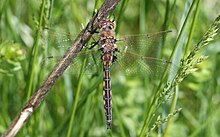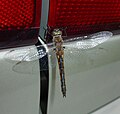Epitheca

| Epitheca | |
|---|---|
 | |
| Common baskettail | |
| Scientific classification | |
| Domain: | Eukaryota |
| Kingdom: | Animalia |
| Phylum: | Arthropoda |
| Class: | Insecta |
| Order: | Odonata |
| Infraorder: | Anisoptera |
| Family: | Corduliidae |
| Subfamily: | Corduliinae |
| Genus: | Epitheca Burmeister, 1839 |
| Type species | |
| Libellula bimaculata Charpentier, 1825 | |
Epitheca is a genus of dragonflies in the family Corduliidae. They are commonly known as baskettails. Baskettails' distinction is the specially adapted, upturned abdomen tip of the females which allows them to carry their egg masses in a small, orange-tinted globule.[1]
Some authorities spin off the North American baskettails into two new genera, Epicordulia and Tetragoneuria, but this has not gained widespread acceptance and most references place them under this genus.[2]
Species
[edit]The genus contains the following species:[3]
| Image | Scientific name | Common Name | Distribution |
|---|---|---|---|
 | Epitheca bimaculata (Charpentier, 1825) | Eurasian baskettail | Serbia and Kaliningrad Oblast, Russia, Ukraine |
 | Epitheca canis (McLachlan, 1886) | beaverpond baskettail | Canada and northern United States. |
 | Epitheca costalis (Selys, 1871) | slender baskettail or stripe-winged baskettail | eastern and southern United States |
 | Epitheca cynosura (Say, 1840) | common baskettail | eastern and southern United States |
| Epitheca marginata (Selys, 1883) | China, Korea, Japan | ||
 | Epitheca petechialis (Muttkowski, 1911) | dot-winged baskettail | South central United States |
 | Epitheca princeps Hagen, 1861 | prince baskettail | midwestern and eastern United States. |
 | Epitheca semiaquea (Burmeister, 1839) | mantled baskettail | eastern United States. |
 | Epitheca sepia (Gloyd, 1933) | sepia baskettail | North America |
 | Epitheca spinigera (Selys, 1871) | spiny baskettail | northern United States and southern Canada |
| Epitheca spinosa (Hagen in Selys, 1878) | robust baskettail | eastern United States. | |
 | Epitheca stella (Williamson in Muttkowski, 1911) | Florida baskettail | Florida |
Notes
[edit]- ^ "Baskettails".
- ^ Garrison, Rosser W.; von Ellenrieder, Natalia; Louton, Jerry A. (2006). Dragonfly Genera of the New World. The Johns Hopkins University Press. p. 157. ISBN 0-8018-8446-2.
- ^ Martin Schorr; Martin Lindeboom; Dennis Paulson. "World Odonata List". University of Puget Sound. Retrieved 11 August 2010.
References
[edit]- "North American Odonata". University of Puget Sound. 2009. Archived from the original on 11 July 2010. Retrieved 5 August 2010.
- Genus Epitheca - Baskettails, BugGuide
- Image of female baskettail sp. with egg mass on tip of tail